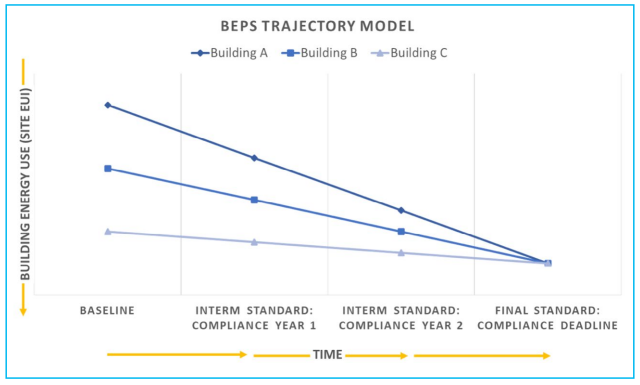Montgomery County BEPS (Bill 16-21) Updates for Building Owners
Introduction
The Montgomery County Council introduced Bill 16-21 on May 4, 2021 as part of county efforts to reduce greenhouse gas emissions 80% by 2027, and reach carbon neutrality by 2035. Residential and commercial buildings contributed ~50% of the county’s greenhouse gas emissions in 2018. Bill 16-21 will require owners of county buildings and commercial and multifamily buildings >25,000SF to benchmark the energy usage intensity (EUI) of their buildings each year, as well as decrease their EUI and meet building energy performance standards (BEPS) every four years. The bill was put together by the Department of Environmental Protection, passed from the County Executive to the Council, and has gone through one public hearing and three working sessions with the Transportation, Infrastructure, Energy, & Environment Committee since the Council introduced it. It is scheduled to go before the Council for final reviews and votes soon, with the intent of setting technical details by June, 2022, and adopting the BEPS program by Earth Day, 2024. Although the bill will provide flexibility on how building owners meet the standards, once it is in place owners will need to take immediate action.
As a leader in energy engineering and construction, CEG helps building owners comply with local energy compliance laws such as the Montgomery County BEPS (Bill 16-21). Once the BEPS are established, CEG will guarantee compliance for building owners, typically at no net cost, by implementing building performance improvements that yield utility savings and reduce carbon intensity. While this article focuses on Montgomery County, additional information regarding our guaranteed compliance offering in other jurisdictions with energy performance standards is found here.
What are the Montgomery County BEPS?
The Montgomery County BEPS will set minimum energy performance standards by building type for county and privately-owned buildings >25,000 SF. Buildings in each building type will have to meet the same standard by the compliance deadline. Energy performance will be measured as normalized energy use intensity (EUI, in kBtu/SF), which measures how efficiently a building uses energy relative to its size.
Under the current Building Energy Benchmarking Law, county buildings and building owners of non-residential buildings >50,000SF are required to report energy consumption data annually on June 1st. Bill 16-21 will expand the requirement to cover non-residential and multifamily buildings >25,000SF. Benchmarking will be used to establish baseline energy consumption for buildings, as well as to evaluate them for BEPS compliance every four years. Buildings will complete three years of benchmarking to create a baseline before they are entered into the first BEPS phase. Interim standards will be set based on each building’s own performance trajectory, so that buildings’ energy consumption decreases in a straight line from the baseline to the final standard, meaning that poor performing buildings will have to decrease their EUI faster than well performing buildings. Buildings will be grouped and phased in over time, as described below.
Source: https://www.montgomerycountymd.gov/green/Resources/Files/energy/beps-one-pager.pdf
What is the timeline for the Montgomery County BEPS?
The timeline is determined by building group, as defined by the county.
County buildings and Groups 1&2 are already reporting benchmarking data under the Benchmarking Law, and include county buildings >50,000SF, and privately-owned non-residential buildings >250,000SF (Group 1) and >50,000SF (Group 2).
Group 3 buildings include county and privately-owned non-residential buildings 25,000-50,000SF, as well as buildings >50,000SF that were previously exempted.
Group 4 buildings include residential buildings >250,000SF.
Group 5 buildings include residential buildings 25,000-250,000SF.
Each building group will be phased in over time.
County and Group 1&2 buildings are already benchmarking, and their baseline will be established in 2022. The first interim standard is 2026, the second is 2030, and the final is 2034.
Group 3&4 buildings will start benchmarking in 2022, and their baseline will be established in 2024. The first interim standard is 2028, the second is 2032, and the final is 2036.
Group 5 buildings will start benchmarking in 2023, and their baseline will be established in 2025. The first interim standard is 2029, the second is 2033, and the final is 2037.
Source: https://www.montgomerycountymd.gov/green/Resources/Files/energy/beps-faqs.pdf
What type of future regulations will be set?
The technical details of the Montgomery County BEPS will be established by June 2022. These details include:
Groupings by building type
Specific performance standards for each building type
Format for Building Performance Improvement Plans (BPIP, see below)
Criteria for economic feasibility and other factors that determine whether BPIPs are allowed or not
Adjustments and assistance available to under-resourced building sectors such as small businesses, affordable housing, non-profits, and houses of worship
Special circumstances
If a building cannot meet the interim or final standards due to economic infeasibility or other factors out of their control, owners can submit a Building Performance Improvement Plan (BPIP) with an alternate implementation plan, as well as a timeline for which they will implement it. The plans will be reviewed by an Advisory Board.
Building owners will be able to receive a credit towards performance for onsite solar generation.
The BEPS will not cover buildings if more than 50% of the area is used for public assembly in a building without walls; industrial uses where the majority of the energy is consumed for manufacturing, the generation of electric power, or generation of district thermal energy consumed offsite; or transportation, communications, or utility infrastructure.
Owners can request waivers from compliance if they are under financial distress; there was less than one full time employee on average that occupied the building; the building is newly constructed and has a certificate of use and occupancy for the year of the benchmarking; or the building is demolished or has a demolition permit.
Does my building meet the Montgomery County BEPS requirements?
When a building is phased in under the BEPS, building EUI must be at or below the performance standard when benchmarking data is reported during the evaluation years. If the EUI is above the performance standard for the building type, then owners can submit a BPIP for compliance. The BPIP must include documentation of current circumstances, a list of potential improvements, a timeline for these improvements, and estimated energy savings that will be realized.
What if my building does not meet the requirements?
If a building does not meet the requirements and the BPIP is not accepted, owners will be charged with a Class A violation under Method 2 regulations.
Conclusion
The Montgomery County BEPS will require building owners to reduce building EUI every four year to meet interim and final energy performance standards.
Once the details of the BEPS are established, CEG will guarantee compliance with the them. We have extensive energy engineering experience, and will identify, design, and implement energy savings improvements in your building to decrease its EUI and meet the standards. Beyond compliance, our turnkey projects can reduce utility and operating costs thereby improving net operating income (NOI). We can offer full financing packages and can help you take advantage of all available incentives, grants, and rebates to eliminate upfront costs. Contact us today.


